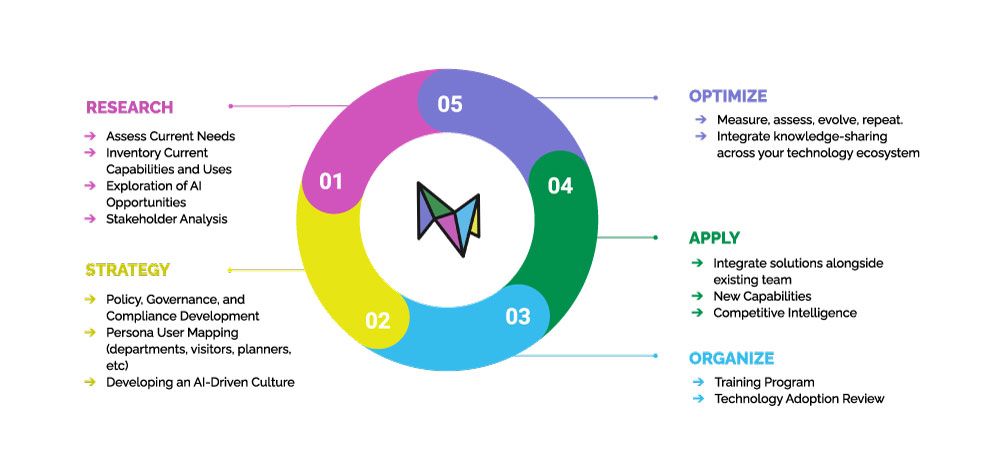Building an AI-Enabled DMO Part 2: The Roadmap
March 12, 2024
The following is the second part of a two-part series providing a model for integrating AI into your organization’s workflow. Part one focuses on the pillars that should be the center of adopting AI as a DMO.
An AI-enabled DMO understands how to leverage the technology to streamline tasks, conduct research and data analysis, as well as to spark imagination. But with a plethora of AI tools boasting all sorts of capabilities now available, it can be difficult to determine how to best fit them into your DMO’s journey.
How do you get there?
Successfully adopting the technology to apply AI solutions within your DMO can be achieved through a circular management model. This approach embraces the technology’s swift progress through repetitive learning and flexible adaptation, while allowing for continual refinement and incremental changes to manage risks, and encourage a culture of innovation.

The First Thing: Research
While it may be tempting to dive right into AI, starting with a bit of research will better position your DMO for successful integration.
Access Current Needs
Engage with department heads within your organization to gather qualitative data on their pain points, aspirations, and requirements. Consider incorporating employee surveys and workshops to understand daily operational challenges that AI can address. While looking at internal operations, don’t forget to look externally as well. Analyze customer feedback and market trends to determine where AI can enhance the visitor journey and improve engagement with your destination.
Inventory Current Capabilities and Uses
Audit your DMO’s existing technological infrastructure to evaluate the readiness for AI integration and identify necessary upgrades. Review current software and tools being used across the organization to avoid duplicity and assess how AI can enhance these tools. Catalog the digital skills present within the team to identify gaps that AI can fill or where training may be needed.
Explore AI Opportunities
Once you have an understanding into your organization’s needs and capabilities, perform a competitive analysis to discover AI-driven innovations that competitors have implemented. Research proven AI applications and emerging trends within the tourism and marketing industries. Then brainstorm with cross-functional teams within your organization to explore creative uses of AI in enhancing campaign strategies and destination marketing.
The Second Thing: Strategy
The next step involves turning your research into a framework for AI integration, ensuring that the plans are robust, ethical, and enhance user experience.
Policy, Governance, and Compliance
Develop comprehensive AI policies that encompass ethical use, data security, privacy, and transparency, keeping in line with legal standards and industry best practices. Set up internal governance structures that include roles and responsibilities for oversight, ethical review, and processes for continuous policy updates to adapt to evolving AI landscapes. Ensure that all AI solutions meet regulatory requirements, with a focus on data protection and accessibility standards.
Persona User Mapping
Create detailed personas for various user groups such as internal departments, visitors, and event planners, drawing on data analytics, surveys, and feedback to understand the unique needs of each group. From there, map out the touchpoints where AI can enhance the user experience for each persona, whether through personalized recommendations for visitors or streamlined planning processes for event organizers. Use these personas to tailor training programs, user interfaces, and communication strategies, ensuring that the AI solutions resonate with and are accessible to all users.
AI-Driven Culture
To successfully incorporate AI, staff need to feel confident with the technology. In order to help your team utilize the tools, plan internal campaigns to educate and excite the team about AI’s potential, emphasizing its role in enhancing creativity and efficiency, rather than replacing human input. Incorporate AI literacy into learning and development programs, ensuring all team members are equipped with the knowledge to engage with AI tools effectively. Finally, foster an environment of experimentation and innovation, encouraging employees to propose and pilot AI solutions, and recognize contributions that drive AI integration forward.
The Third Thing: Organize
Once your framework is complete, it’s time to put it into action with building the necessary skills within your team for seamless integration.
Technology Adoption Review
With what you now know from researching and strategizing your framework, take a step back to audit the current tech stack to identify redundancies, gaps, and potential for integration with new AI tools. Evaluate AI tools and vendors, considering factors such as scalability, support, compatibility with existing systems, and alignment with the agency’s mission and values.Then initiate pilot tests of selected AI technologies within certain departments or projects to evaluate their effectiveness and identify any barriers to adoption. Set up systems to collect feedback from team members on the usability and impact of these tools, ensuring their insights guide the optimization process. Before applying the technology, develop a detailed plan with timelines, responsible parties, and resources required for full-scale implementation, ensuring transparency and accountability.
Training Program
Develop a training curriculum that addresses AI fundamentals, ethical considerations, specific tools and technologies, data analysis, and application in marketing strategies. Foster collaborative learning environments, such as peer-led training sessions or “AI in Action” groups, where team members can share insights and learn from one another’s experiences with AI applications. Create an environment where the discussions are ongoing and allow for regular feedback to continually assess and enhance the training program, adapting to the team’s evolving needs and the latest AI developments.
The Fourth Thing: Apply
During this phase, the focus shifts to the practical deployment and enhancement of AI-driven capabilities.
Integrate Solutions
Establish cross-functional teams to foster a shared understanding of AI tools across different departments, enhancing collaborative efforts, as well as identify and empower “AI Change Champions” within the team who can act as ambassadors for the new technology, providing support and encouraging adoption among their peers. In addition, be proactive in providing ongoing IT and peer support structures to address technical issues and operational questions as the team gets accustomed to the new AI tools.
New Capabilities
Set up innovation labs where team members can experiment with AI tools to discover new uses and applications relevant to their work, thus fostering a culture of continuous innovation. Work alongside IT teams and departments to implement new technologies and solutions into the appropriate capability maps across the organization.
Competitive Intelligence
While you’re focused on internal integration, don’t lose sight of external factors. Deploy AI-driven analytics to gather and process vast amounts of competitive data, strategies identifying trends, benchmarks, and opportunities for differentiation in the market. Stay ahead of the curve by applying predictive modeling and scenario analysis to forecast future market developments.Take it further, by implementing sentiment analysis to gauge the impact of both your campaigns and your competitors’ marketing campaigns on public perception and traveler behavior.
The Fifth Thing: Optimize
As previously mentioned, the model for AI integration is circular, never truly “done.” This phase focuses on the continual enhancement and refinement of AI initiatives through a process of measurement, assessment, evolution, and repetition. It is crucial to ensuring that AI applications remain effective and aligned with your strategic goals.
Agile Management
Establish clear performance metrics to evaluate the effectiveness of AI-driven initiatives against key objectives. Conduct regular assessments to review these metrics, identifying areas where AI tools and strategies have succeeded or need improvement. Based on assessments, rapidly evolve strategies, tools, and processes to address gaps, leveraging the agility of AI technologies to implement changes. Implement a schedule of iterative cycles for review and enhancement, ensuring that the optimization of AI tools is continuous and responsive to new data and outcomes.
Knowledge sharing
Support learning among your team through initiatives such as workshops, webinars, and training modules focused on maximizing the benefits of AI. Establish structured feedback loops that encourage staff to share their experiences and suggestions regarding AI tools, fostering a culture of collective growth and continuous improvement. Finally, build a repository of best practices, case studies, and success stories to serve as a resource for ongoing education and inspiration.
Following the Roadmap
As you journey toward an AI-enabled DMO, taking the time to follow this roadmap of researching, strategizing, organizing, applying, and optimizing will help ensure a smooth integration of the technology. It will also position your organization to adapt to this rapidly developing technology. When used correctly, AI tools can be transformative, whether through streamlining tasks, research and data analysis, or sparking imagination — it only takes that first step to begin unlocking the potential of AI.



